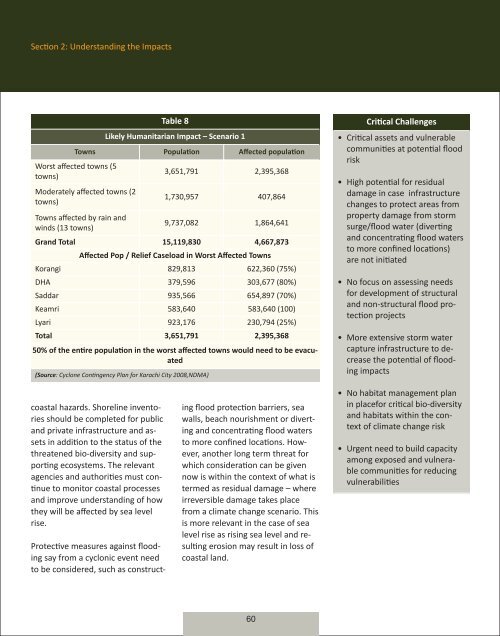27915_100286295karachicityclimatechangead
27915_100286295karachicityclimatechangead
27915_100286295karachicityclimatechangead
You also want an ePaper? Increase the reach of your titles
YUMPU automatically turns print PDFs into web optimized ePapers that Google loves.
Section 2: Understanding the Impactstable 8likely humanitarian Impact – Scenario 1towns population Affected populationWorst affected towns (5towns)Moderately affected towns (2towns)3,651,791 2,395,3681,730,957 407,864Towns affected by rain andwinds (13 towns)9,737,082 1,864,641grand total 15,119,830 4,667,873Affected pop / relief Caseload in worst Affected townsKorangi 829,813 622,360 (75%)DHA 379,596 303,677 (80%)Saddar 935,566 654,897 (70%)Keamri 583,640 583,640 (100)Lyari 923,176 230,794 (25%)total 3,651,791 2,395,36850% of the entire population in the worst affected towns would need to be evacuated(Source: Cyclone Contingency Plan for Karachi City 2008,NDMA)Critical Challenges• Critical assets and vulnerablecommunities at potential floodrisk• High potential for residualdamage in case infrastructurechanges to protect areas fromproperty damage from stormsurge/flood water (divertingand concentrating flood watersto more confined locations)are not initiated• No focus on assessing needsfor development of structuraland non-structural flood protectionprojects• More extensive storm watercapture infrastructure to decreasethe potential of floodingimpactscoastal hazards. Shoreline inventoriesshould be completed for publicand private infrastructure and assetsin addition to the status of thethreatened bio-diversity and supportingecosystems. The relevantagencies and authorities must continueto monitor coastal processesand improve understanding of howthey will be affected by sea levelrise.Protective measures against floodingsay from a cyclonic event needto be considered, such as constructingflood protection barriers, seawalls, beach nourishment or divertingand concentrating flood watersto more confined locations. However,another long term threat forwhich consideration can be givennow is within the context of what istermed as residual damage – whereirreversible damage takes placefrom a climate change scenario. Thisis more relevant in the case of sealevel rise as rising sea level and resultingerosion may result in loss ofcoastal land.• No habitat management planin placefor critical bio-diversityand habitats within the contextof climate change risk• Urgent need to build capacityamong exposed and vulnerablecommunities for reducingvulnerabilities60












